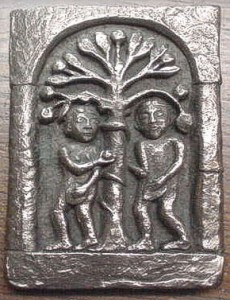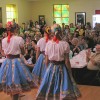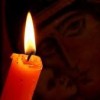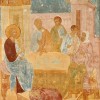Source: In Communion: Web Site of the Orthodox Peace Fellowship
 Many think about Adam and Eve from the perspective of debates about the age of the universe and the origin of human beings. The Church Fathers and the liturgy have a completely different starting point, less in terms of cosmology than Christology. The Church rarely mentions Adam without speaking of Christ, so that we reckon the “Old Adam,” or “First Adam,” in terms of the “New Adam.” This orientation of thinking about Adam helps us to understand our lives as baptized Christians, as human beings who are both fallen and raised, distorted and renewed, dying yet redeemed from death. In our baptism and sacramental life, we have died to the Old Adam and put on the New Adam – yet we are somehow partaking of both. Our cosmological questions may remain, but they receive new perspective from the Church’s reckoning of Adam. Let us humbly ask God and his Church about Adam, and see what we find.
Many think about Adam and Eve from the perspective of debates about the age of the universe and the origin of human beings. The Church Fathers and the liturgy have a completely different starting point, less in terms of cosmology than Christology. The Church rarely mentions Adam without speaking of Christ, so that we reckon the “Old Adam,” or “First Adam,” in terms of the “New Adam.” This orientation of thinking about Adam helps us to understand our lives as baptized Christians, as human beings who are both fallen and raised, distorted and renewed, dying yet redeemed from death. In our baptism and sacramental life, we have died to the Old Adam and put on the New Adam – yet we are somehow partaking of both. Our cosmological questions may remain, but they receive new perspective from the Church’s reckoning of Adam. Let us humbly ask God and his Church about Adam, and see what we find.
In Genesis, we hear God calling to his creature, Adam, who has just disobeyed the divine command and who has hidden himself: “Adam, where are you?”
We also may ask, with love and in a spirit of holy inquiry, “Adam, where are you?” And perhaps, “Adam, who are you?” “Adam, what are you?”
“Adam where are you? You have hidden from God in shame, but you are also hidden from our view. You are there at the beginning of our Bible and at the very end, and nowhere in between.
“Adam, who are you? Your name in Hebrew means both ‘humanity’ and ‘of the earth.’ Are you ‘man’ as a totality, or a single person? Or both at once? Or are you me and am I you, when I disobey God’s command in my own life? Or are you all of these things, and perhaps more than all? Adam, can you tell us something about ourselves, and our life in this world? For the divinely inspired Scriptures have surely told us about you so that you may teach us about God’s purpose.”
St. Silouan of Mount Athos brings far more beautiful words to Adam. In a deeply moving meditation, he sees Adam at first lamenting painfully at the loss of his closeness with God, and then completely enraptured with joy in the Lord who has given him a still greater Paradise in communion with the Holy Trinity.
O Adam, sing unto us a heavenly song
that the whole earth may hearken,
and delight in the peace of love toward God.
In St. Silouan’s writing, we have an important clue to who and what Adam was in the paradise of old: he was in a state of sweetness and gladness, looking upon God. But he was not perfect. He was not yet in the state of a fully redeemed, deified, immortal man in the “fairer Paradise” given in Christ through his cross.
It is important for us to recall that the Adam we meet in the book of Genesis is not the icon of perfected humanity. He and Eve were “naked and unashamed,” but they were neither perfect nor immortal. As the Divine Liturgy of St. Basil the Great puts it, God put his human creature in Paradise with the promise of immortality. Adam and Eve are human beings in the making. They are works in progress.
This is the conviction of several of the Church Fathers, including St. Irenaeus of Lyons, St. Gregory of Nazianzus, and St. Ephrem of Syria. The forbidden tree in Paradise was not evil in itself, and was meant for human beings, but it was meant to be eaten of at the right time and in the right disposition. Adam and Eve’s tragedy was to eat of it when they were still as children – innocent and immature.
The biblical story shows us that Adam and Eve are not perfectly fulfilled human persons. What was it in Eve that made her listen to the voice of the serpent? That is not perfection. We speak of God-given “freedom,” but their freedom to forget God is not the genuine freedom of the deified human person. True freedom is freedom in God, the freedom to do the good, not the freedom to listen to this pathetic snake.
Adam and Eve are creatures of potential, on the way to fully realized perfection. They – we – were created for life, not death – for life in union with God. But they do not attain it. And so Adam, in the mind of the Fathers, and in the hymns of the liturgy, never represents royal, deified man, but fallen man. When the hymns speak of “Adam” they mean “fallen humanity.” Nearly every feast of Christ recalls this. At the feast of the Transfiguration, for example, we sing:
You were transfigured, O Christ,
And made Adam’s darkened image to shine again as lightning,
Transforming it into the glory and splendor of Your own divinity….
Here we are not talking about an ancient historic man, “Adam.” If Christ came only to raise some single person, that would certainly not have the effect of reshaping the whole cosmos. Christ comes to raise fallen humanity. He comes to raise us.
This leads to the question not just “who is Adam,” but “who are we?” If Adam is fallen humanity, and Adam is us, then are we fallen humanity? Yes we are. But aren’t we renewed humanity, in Christ? Yes we are. We are both, and must choose between orienting ourselves in Christ or orienting ourselves in Adam. As we sing at the Matins of Holy Saturday:
You descended to the depths of the earth to fill all with Your glory;
For my person that is in Adam was not hidden from You.
And when You were buried,
You renewed me who am corrupt, O Lover of mankind.
So I can consider “my person that is in Adam” and at the same time I know my person that is in Christ. I am both. We are back to the paradox with which we began. We are baptized in Christ and in principle dead to Adam – i.e., to fallen humanity – yet we still sin. And our every sin reveals us to be still living in Adam.
This is another theme throughout the Church Fathers and our hymnography: Adam is us as “fallen humanity,” but also we are Adam. We are creatures of potential who constantly repeat and perpetuate the sin in the garden. Everything that is reported in the garden of paradise, with regard to Adam’s sin, pertains to us and our sin. “I came to know my nakedness and clothed myself in a garment of skin, and fell from the garden” (St. Gregory of Nazianzus, Oration 19.14). “My ancestor’s weakness is my own” (Or. 38.12). “We were entrusted with Paradise that we might enjoy life. We received a commandment so that we might obtain a good repute by keeping it…. We were deceived because we were the objects of envy. We were cast out because we transgressed. We fasted because we refused to fast, being overpowered by the tree of knowledge.” (Or. 45.28)
Who is the subject of this sad tale? It is, again, not an ancient historical Adam. It is us. We sing, on the eve of Great Lent:
Long ago the crafty serpent envied my honor
And whispered deceit in the ear of Eve.
Woe is me! I was led astray
And banished from the dance of life.
And so, Adam is our forefather. But the next question is: is he our forefather in the spiritual sense, the moral sense, or in the genealogical sense? In other words, can we be said to have descended from Adam, in the same way that I have descended from a particular line of parents and grandparents and great-grandparents? Genealogically and genetically? This is a further question we are led to ask, especially in view of new perspectives from history and science.
“Adam, where are you: in our historical past? Are you in the same plane of history as Winston Churchill, Leonardo DaVinci, and Plato?” On what basis may we approach this question? To whom may we pose it? Can we look to the Fathers to answer it? Were they even concerned with “historicity” as we are in our post-Darwin era?
In fact some of the Fathers were interested in this question. There were those who answered in a very literal way, such as Theophilus of Antioch, who provided a date in history for the creation of the world and of Adam. (To this day, there are those who assert, in order to be harmonious with the Scriptural genealogies, that the universe was created somewhere between 5,000 and 10,000 years ago. St. Augustine noticed that if we were to take literally all the chronologies in Genesis, Methuselah would have had to be present on Noah’s Ark.)
Other Fathers were a great deal more open about the Paradise story and what it may have represented. Possibly the best example of this open inquisitiveness was St. Gregory the Theologian, who writes that God placed the human person in Paradise, “Whatever that may mean.” He speculates that the tree of knowledge may have represented theoria, contemplation. He sees the Paradise story as one open to several interpretations. St. Gregory endorsed Origen’s view that the Paradise described in Genesis did not reside in our historical space and time:
Who will be found simple enough to believe that, like some farmer, “God planted trees in the garden of Eden, in the east” and that he planted “the tree of life” in it, that is a visible tree that could be touched, so that someone could eat of this tree with corporeal teeth and gain life, and further, could eat of another tree and receive the knowledge of “good and evil?” … [T]hese are figurative expressions which indicate certain mysteries through a semblance of history and not through actual events. [De Principiis 4.3.1. The passage cited here is part of the Philokalia of Origen, an anthology of Origen’s texts compiled by Sts. Basil the Great and Gregory the Theologian.]
Some Fathers were interested in the question as to whether Adam and Eve and Paradise existed in the same way that, for us, Hyde Park – and those walking within it – exist in London. They answered this question in different ways. Most probably believed that Adam existed as a historical person rather than in a mythical realm, for they had no scientific reason not to. Yet none of their theological conclusions about Adam and what he represents require him to exist as a particular historical human being.
The Orthodox theologian Jean-Claude Larchet proposes two categories of history, or temporal orders. He says that the chronological history which we try to document scientifically is already the history of fallen humanity. Our history resides on a different plane from the “spiritual history” described in Genesis:
The original condition of man as it is presented by Scripture and the Fathers is situated in another temporal order than that of historical knowledge: it does not belong to the time of sensible realities (chronos), but to the duration of spiritual realities (aiфn), which eludes historical science because it belongs to the sphere of spiritual history.[Theology of Illness, St. Vladimir’s Seminary Press, p. 23 n. 51]
Larchet’s model helps us make sense of modern science while retaining the inspired integrity of the scriptural story.
We may conclude that Adam is our forefather in the sense of representing what we came from, representing a failure of potential, representing us whenever we repeat that failure, representing the Old Man whom we shed in our baptism in favor of the New Man Jesus Christ. He is also our forefather in the sense of showing that there was a beginning to sin and death. Sin and death are not an eternal reality. They began, and spread to all.
When “Adam” means “fallen man,” he is rarely mentioned in our hymns apart from Christ — who by clothing himself in Adam (= humanity, = us), restores Adam, recalling the divine image, bringing fallen humanity to the place that was always intended for it: into union with God himself. Christ, therefore, is the New Adam, the Second Adam.
Aside from representing the “Old Man,” Adam is also the prefiguration of Christ. In theological and scriptural language, Adam is a “type” for Christ. In Romans, St. Paul already calls Adam “a type of the one to come” (typos tou mellontos). Adam is a “place-holder” for Christ. Adam/humanity was given the vocation to be a true human person — and failed in every respect. It is Christ — being the Word of God (the prophet), the living sacrifice (the priest), and the king of glory — who fulfills the human vocation perfectly.
Indeed, as several of the Fathers put it, you can either see Adam as the “type” for Christ, or more properly you can see Adam as being made in the image of Christ – even, in the eternal perspective, in the image of the crucified Christ. As St. Nicolas Cabasilas wrote:
It was not the old Adam who was the model for the new, but the new Adam for the old. … For those who have known him first, the old Adam is the archetype because of our fallen nature. But for him who sees all things before they exist, the first Adam is the imitation of the second. [The Life in Christ 6.91-94.]
As St. Irenaeus has it, “it was necessary that one who would be saved [Adam] should also come into existence, in order that the One who saves should not exist in vain.” [Adv. Haer. 3.22.3]
All of this is a part of the Church’s rich tradition of typology, which we will probably recognize from the Church’s hymnography. Adam is a type for Christ, Eve a type for Mary. The tree in Paradise is a type for the tree of the cross, and paradise itself is a type for the Church, which is God’s Kingdom on earth. In fact, the Fathers leave almost no element in the Old Testament unexplored for its typological potential. Moses’s outstretched hands are a type for the crucified Christ. Christ himself, in the gospels, repeatedly tells his disciples that what was written in the Scriptures, in other words written in the Old Testament, was all written about him. “Moses wrote of me,” says the Lord in John 5:46 and in Luke 24. Christ explains to his disciples how the entire Old Testament concerns himself.
This is illustrated in a beautiful liturgical act. During Lent, at the Liturgy of the Presanctified Gifts, we read from the Old Testament, beginning with Genesis: the creation of the world in six days, and the story of Adam and Eve in the garden. And just after this reading, we all bow down to the ground, our faces to the floor, while the celebrant comes out of the sanctuary with a candle placed on the gospel book, proclaiming, “The light of Christ illumines all.” Indeed, the light of Christ illumines all that is told in the Old Testament Scripture.
And so Adam, who represents fallen man, represents a type or prefiguration of the New Man, Christ. St. Gregory the Theologian makes a poetic one-to-one relationship between the two, contrasting the hands of Christ – stretched out in generosity and fixed by nails – with the hand of Adam, stretched out in unrestrained self-indulgence. Christ is lifted up (on the cross) to reverse Adam’s downward fall. Christ ingests vinegar instead of Adam’s fruit. Christ dies for Adam’s death, and is raised so that Adam may be raised. He says, also:
All of us …partake of the same Adam, and were led astray by the serpent and slain by sin, and are saved by the heavenly Adam and brought back by the tree of [the cross] to the tree of life from which we had fallen. [Oration 33.9]
This brings us back to the paradox of our lives in this world, both fallen and redeemed, redeemed and fallen. We revisit this paradox in the light of the Old and New Adam.
Let us look at what is practically the last mention of Adam in the Old Testament, in Genesis chapter 5, drawing from the Septuagint Greek translation:
This is the book of the origin of human beings. On the day that God made Adam, he made him according to the divine image; male and female he made them, and he blessed them. And he named their name “Adam” on the day that he made them. Now Adam lived two hundred thirty years and became a father, according to his form and according to his image, and named his name Seth. And the days of Adam after he became the father of Seth amounted to seven hundred years, and he had sons and daughters. And all the days of Adam, that he lived, amounted to nine hundred and thirty years, and he died.
God makes “Adam” – meaning humanity, male and female – in his image. And then Adam, having fallen, has a son according to his image. And what follows in this chapter is a long genealogy that leads to Noah, who lives in an age of violence and depravity. This shows us what “the fall” is: human beings, created in the divine image, are now in the image of Adam. God is not gone, nor is his image in us, but now everyone who is born, is in Adam’s image as well as in God’s.
We know what follows. Jesus Christ, the living image of God, is born in history. The pre-eternal Son of the Living God, is born of a woman, a virgin – herself born in the image of Adam, and he lives a fully human life. It is this Jesus, this New Adam, fully divine and fully human, who restores the image of God. And so, now we may live in Christ, we may die in Christ, and be raised in Christ.
The paradox remains, but it is entirely redefined. Life and death are transfigured by God, in the life and death of his Son. The divine image is restored in all its splendor, and that image, or icon, is Jesus Christ, the New Adam. But like every dimension of our life in the world as Christians in the Church, this restoration is both a gift and a calling.
Our baptism is our death. From that point onward we are alive in Christ, in the Church, through the sacraments. Death, which continues to bind us biologically, no longer defines us spiritually. This is a gift, given to us freely. It is also our calling to take it up, at every moment of our lives. At every moment we may choose to live in the Old Adam – to yield to the self-justifying call of the serpent and pursue a deification without the cross – or to live in the New Adam, taking up the cross and following Christ.
Our call, “Adam, where are you?”, now finally yields to the constant seeking out of the New Adam, and the constant calling out to him by his holy name: “Lord Jesus Christ, Son of God, have mercy on me a sinner.”
Our paradoxical life as fallen yet redeemed persons is now taken up by the task of constantly reorienting our perspective, training our sites on Christ, the true image of God. That’s what we’re to do in and through the Church, Christ’s body. This is the meaning of asceticism, our universal calling: the redirection of our whole person, mind, body and soul. Living in Christ, we continue to suffer, we continue to be tempted, we continue to sin. But all this is decisively overcome, changed.
But that is not the only message of the gospel. The other vital message that God gives us in the New Adam is that he loves us beyond measure. He gives everything to us. And he knows our suffering in this life of paradox, because he enters it. He is not simply watching passively. No, he knows our pain, and he comes to experience it to its very fullest extent.
With our gaze thus fixed on the New Adam, our Lord and Savior Jesus Christ, we cry out with all conviction and all joy: Christ is Risen!
Peter Bouteneff teaches dogmatic theology, patristics, and spirituality at St. Vladimir’s Seminary. He has a doctorate from Oxford University, where he studied under Bishop Kallistos Ware. This is a shortened version of a paper he delivered in May at the 13th Western European Orthodox Congress, held in Amiens, France. He is the author of Beginnings: Ancient Christian Readings of the Biblical Creation Narratives (Baker Academic, 2008).
















